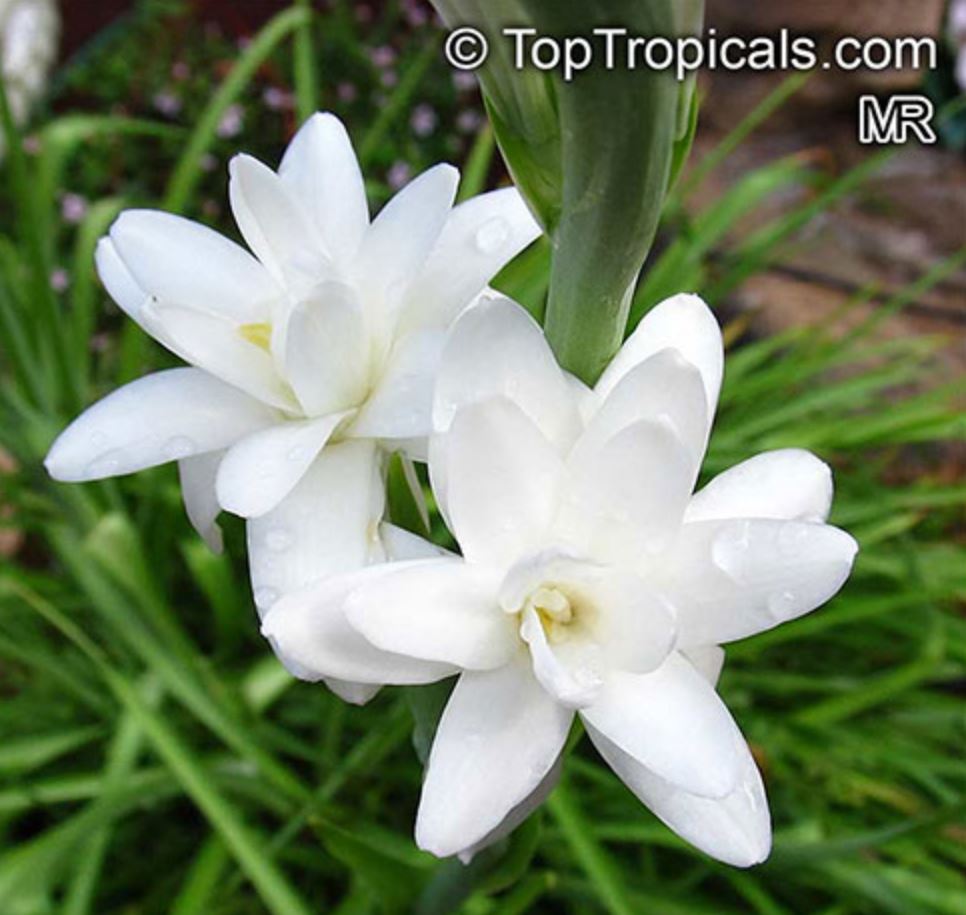Agave amica? Polianthes tuberosa...
A tuberose by any other name would smell as sweet...
by Mark Hooten, the Garden Doc
About the Author
Mark Hooten has been fascinated by horticulture since childhood, with interests including tropical fruits, cacti, ethnobotany, entheogens, and variegates. Having been employed in both FL and CA by botanical gardens and specialist nurseries as horticulturist, manager, propagator, and consultant, he is happy to speak with fellow plant worshipers at TopTropicals Nursery. Mark is currently busy writing a volume on the complicated history of croton varieties. His passions are plants, cats, and art of painting.
 Recently, we received a beautifully grown batch of Polianthes tuberosa, all in one gallon pots. These are commonly called Tuberose in the cut-flower trade. I was so happy to see them that I could hardly contain myself from exploding with joy! It had been such a number of years since I have even seen this plant that I had nearly forgotten about its existence. I first grew it as a little kid "up north", after seeing it listed in an old-fashioned mail-order catalogue, probably Gourney's. I remember doing things like mowing neighbors lawns and shoveling snow from driveways in-order to save enough money so that toward spring I could order a few things from those plant catalogues.
Recently, we received a beautifully grown batch of Polianthes tuberosa, all in one gallon pots. These are commonly called Tuberose in the cut-flower trade. I was so happy to see them that I could hardly contain myself from exploding with joy! It had been such a number of years since I have even seen this plant that I had nearly forgotten about its existence. I first grew it as a little kid "up north", after seeing it listed in an old-fashioned mail-order catalogue, probably Gourney's. I remember doing things like mowing neighbors lawns and shoveling snow from driveways in-order to save enough money so that toward spring I could order a few things from those plant catalogues.
When the time came, I couldn't decide whether or not to order the single or double flowered type as they offered both, so I ordered some of each kind. Actually, neither one was a disappointment. However while the double flowered kind called 'Pearl' was visually more appealing, it was the original single petaled kind which produced the most intense fragrance. Since then, numerous hybrids have been made by various scientific institutions. The vast majority of them have been created by the Indian Institute of Horticultural Research located in Bangalore, India. These hybrids were developed for both the cut flower trade, and the perfume industry, and those varieties are generally one kind or the other. There are a couple of cultivars which stand out because of their vigor and exceptional essential-oil production (which, BTW, is as or more commercially valuable than the the essential oils of either ylang-ylang or attar of rose!). Most happily, what we are offering is the one called 'Shringar'. It was developed for both the perfume AND cut-flower industries! The plant is larger, more vigorous, and hardier than the old-fashioned Mexican type I grew as a kid. Even the flower-spikes are noticeably more vigorous, easily reaching three feet in height, producing larger, more numerous, more fragrant and longer lasting blossoms. These flowers waft the scent of both roses and honeysuckle... a mind-blowing combination!
Personally, I recommend growing them in a sizable pot which can be brought indoors during the winter (when they go totally dormant), a necessity if you live in a cold climate. Basically, they want no water (or only VERY little during the winter). They REQUIRE at-least a half day or more of full sun when actively growing, and being planted in a rich yet well-drained mix.
Also, I find it very fascinating that 40+ years ago, this plant was classified as Polianthes tuberosa in the plant family called Amaryllidaceae (Formerly: Alliaceae/Liliaceae/Amaryllidaceae). Everybody knows Amaryllis. Then, more recently, the taxonomists took a closer look and placed it within the Agave family, which is the Century Plant family, Agavaceae! AND THEN, most recently, cladistic research using high-tech genetic data proved the entire genus once called Polyanthes is composed of only members of the true genus Agave!!! So, what I grew-up knowing as "Polyanthes tuberosa" is now officially "Agave amica". (Amica means "friendly, or of friends" in Latin, BTW).
NOTE from Editor: ...Moreover, they changed the whole Family Agavaceae into Asparagaceae! So technically, both Agaves and Tuberose must be a kind of Asparagus? :)
Also fascinating to me is that this species is known to have been cultivated by both early Mayans and Aztecs according to ancient stone depictions, usually associated with the god Xipe-Totec, the Jaguar deity, making it one of the longest and most revered cultivated "ornamentals" since the very beginning of plant cultivation. THEN, (to me at-least), it is a mind-blowing enigma that this plant has NEVER BEEN FOUND IN THE WILD STATE IN IT'S NATIVE MEXICO... making it a true "cultigen whose origin has been lost to antiquity."
A tuberose by any other name would smell as sweet!

